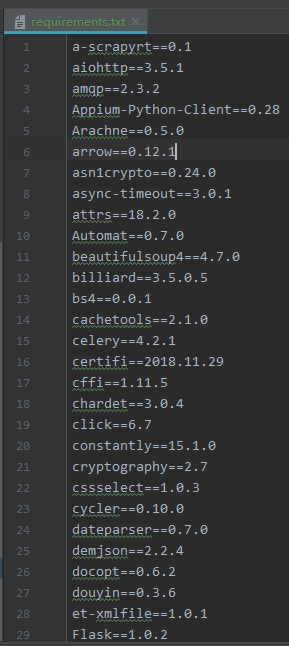Python 模拟员工信息数据库操作的实例
1.功能简介
此程序模拟员工信息数据库操作,按照语法输入指令即能实现员工信息的增、删、改、查功能。
2.实现方法
• 架构:
本程序采用python语言编写,关键在于指令的解析和执行:其中指令解析主要运用了正则表达式来高效匹配有效信息;指令执行通过一个commd_exe主执行函数和增、删、改、查4个子执行函数来实现,操作方法主要是运用面向对象方法将员工信息对象化,从而使各项操作都能方便高效实现。程序主要函数如下:
(1)command_exe(command)
指令执行主函数,根据指令第一个字段识别何种操作,并分发给相应的处理函数执行。
(2)add(command)
增加员工记录函数,指令中需包含新增员工除id号以外的其他所有信息,程序执行后信息写入员工信息表最后一行,id号根据原最后一条记录的id号自增1。
(3)delete(command)
删除员工记录函数,可根据where后的条件检索需删除的记录,并从信息表中删除。
(4)update(command)
修改和更新员工记录函数,根据where后的条件检索需更新的记录,根据set后的等式修改和更新指定的信息。
(5)search(command)
查询员工记录函数,根据where后的条件查询到相应的记录,根据select后的关键字来显示记录的指定信息,如果为*显示记录的所有信息。
(6)verify(staff_temp,condition)
员工信息验证函数,传入一个对象化的员工记录和指令中where后的条件字符串,判断记录是否符合条件,符合在返回True,否则返回False。指令包含where字段的删、改、查操作会调用此函数。
(7)logic_cal(staff_temp,logic_exp)
单个逻辑表达式的运算函数,传入一个对象化的员工记录和从where条件字符串中被and、or、not分割的单个表达式,实现=,>,<,>=,<=,like等确定的一个逻辑表达式的运算,返回结果为True或False。
• 主要操作:
数据记录包含6个关键字:id,name,age,phone,dept,enroll_date
指令可用的逻辑运算符:<,>,=,<=,>=,like,and,or,not
数据库操作:
1.增(add to xxxx values xxxx)
示例:add to staff_table values Alex Li,22,13651054608,IT,2013-04-01
2.删(delete from xxxx where xxxx)
示例:delete from staff_table where age<=18 and enroll_date like "2017"
3.改(update xxxx set xxxx where xxxx)
示例:
update staff_table set dept="Market",age=30 where dept="IT" and phone like "189"
4.查(select xxxx from xxxx where xxxx)
示例1:
select * from staff_table where age>=25 and not phone like "136" or name like "李"
示例2:
select name,age,dept from db.txt where id<9 and enroll_date like "-05-"
示例3:select * from staff_table where * #显示所有记录
•使用文件:
staff_table
存放员工信息表,作为模拟的数据库文件,每条记录包含id,name,age,phone,dept,enroll_date六项信息,如"1,Alex Li,22,13651054608,IT,2013-04-0"。
3.流程图

4.代码
#!usr/bin/env python3
#_*_coding:utf-8_*_
'staff infomation management module'
__author__='Byron Li'
'''----------------------------------------------员工信息数据库操作指令语法---------------------------------------------
数据记录包含6个关键字:id,name,age,phone,dept,enroll_date
指令可用的逻辑运算符:<,>,=,<=,>=,like,and,or,not
1.增(add to xxxx values xxxx)
示例:add to staff_table values Alex Li,22,13651054608,IT,2013-04-01
2.删(delete from xxxx where xxxx)
示例:delete from staff_table where age<=18 and enroll_date like "2017"
3.改(update xxxx set xxxx where xxxx)
示例:update staff_table set dept="Market",age=30 where dept="IT" and phone like "189"
4.查(select xxxx from xxxx where xxxx)
示例1:select * from staff_table where age>=25 and not phone like "136" or name like "李"
示例2:select name,age,dept from db.txt where id<9 and enroll_date like "-05-"
示例3:select * from staff_table where * #显示所有记录
---------------------------------------------------------------------------------------------------------------------'''
import re
import os
class staff(object): #员工类
def __init__(self,*args): #员工信息初始化:从字符串列表传参赋值
self.id=args[0]
self.name=args[1]
self.age=args[2]
self.phone=args[3]
self.dept=args[4]
self.enroll_date=args[5]
self.allinfo=','.join(args)
def update(self,**kwargs): #员工信息更新:从字典传参赋值
if 'id' in kwargs:
self.id=kwargs['id']
if 'name' in kwargs:
self.name=kwargs['name']
if 'age' in kwargs:
self.age = kwargs['age']
if 'phone' in kwargs:
self.phone=kwargs['phone']
if 'dept' in kwargs:
self.dept=kwargs['dept']
if 'enroll_date' in kwargs:
self.enroll_date = kwargs['enroll_date']
self.allinfo = ','.join(map(str,[self.id, self.name, self.age, self.phone, self.dept, self.enroll_date]))
def print_info(self,info): #员工信息打印显示:传入的参数为"*"或数据记录的若干个关键字
if info=='*':
print(self.allinfo)
else:
info=info.split(',')
res=[]
for i in info:
if hasattr(self,i.strip()):
res.append(str(getattr(self,i.strip())))
print(','.join(res))
def command_exe(command): #指令执行主函数,根据指令第一个字段识别何种操作,并分发给相应的处理函数执行
command=command.strip()
return {
'add':add,
'delete':delete,
'update':update,
'select':search,
}.get(command.split()[0],error)(command)
def error(command): #错误提示函数,指令不合语法调用该函数报错
print('\033[31;1m语法错误,请重新输入!\033[0m\n')
def add(command): #增加员工记录函数
command_parse=re.search(r'add\s*?to\s(.*?)values\s(.*)',command) #正则表达式指令解析
if(command_parse):
data_file=command_parse.group(1).strip() #数据库文件
info=command_parse.group(2).strip() #需新增的员工信息,不含id
id=1 #新增员工id,默认为1以防数据库为空表时新增记录id取1
with open(data_file, 'r+', encoding='utf-8') as fr:
line=fr.readline()
while(line):
if line.strip()=='':
fr.seek(fr.tell()-len(line)-2) #定位文件最后一行(只有空字符)的开头
break
staff_temp = staff(*line.strip().split(',')) #读取的信息转换为staff对象
id = int(staff_temp.id) + 1 #末行员工id加1为新员工id
line = fr.readline()
info_new=''.join([str(id),',',info]) #id与其他信息合并成完整记录
fr.write(info_new)
fr.write('\n')
fr.flush()
print("数据库本次\033[31;1m新增1条\033[0m员工信息:", info_new) #新增记录打印
else:
error(command)
def delete(command): #删除员工记录函数
command_parse=re.search(r'delete\s*?from\s(.*?)where\s(.*)',command) #指令解析
if(command_parse):
data_file=command_parse.group(1).strip() #数据库文件
condition=command_parse.group(2).strip() #检索条件
data_file_bak = ''.join([data_file, '.bak'])
count = 0 #删除记录计数
staff_list = [] #删除记录的员工对象列表
with open(data_file, 'r', encoding='utf-8') as fr, \
open(data_file_bak, 'w', encoding='utf-8') as fw:
for line in fr:
staff_temp = staff(*line.strip().split(','))
if (verify(staff_temp, condition)): #验证员工信息是否符合条件
count+=1
staff_list.append(staff_temp)
continue
fw.write(staff_temp.allinfo)
fw.write('\n')
fw.flush()
os.remove(data_file)
os.rename(data_file_bak, data_file)
print("数据库本次共\033[31;1m删除%d条\033[0m员工信息,如下:"%count)
for staff_temp in staff_list:
staff_temp.print_info('*') #删除记录打印
else:
error(command)
def update(command): #修改和更新员工记录函数
command_parse=re.search(r'update\s(.*?)set\s(.*?)where\s(.*)',command) #指令解析
if(command_parse):
data_file=command_parse.group(1).strip() #数据库文件
info=command_parse.group(2).strip() #需更新的信息
condition=command_parse.group(3).strip() #检索条件
data_file_bak=''.join([data_file,'.bak'])
info = ''.join(['{', info.replace('=', ':'), '}']) #将需更新的信息按字典格式修饰字符串
info = eval(re.sub(r'(\w+)\s*:', r'"\1":', info)) #将字符串进一步修饰最终转化成字典
count = 0
staff_list = []
with open(data_file,'r',encoding='utf-8') as fr,\
open(data_file_bak,'w',encoding='utf-8') as fw:
for line in fr:
staff_temp=staff(*line.strip().split(','))
if(verify(staff_temp,condition)): #验证员工信息是否符合条件
staff_temp.update(**info) #调用员工对象成员函数更新信息
count += 1
staff_list.append(staff_temp)
fw.write(staff_temp.allinfo)
fw.write('\n')
fw.flush()
os.remove(data_file)
os.rename(data_file_bak,data_file)
print("数据库本次共\033[31;1m更新%d条\033[0m员工信息,如下:"%count)
for staff_temp in staff_list:
staff_temp.print_info('*') #更新记录打印
else:
error(command)
def search(command): #查询员工记录函数
command_parse=re.search(r'select\s(.*?)from\s(.*?)where\s(.*)',command) #指令解析
if(command_parse):
info=command_parse.group(1).strip() #检索结束后需显示的信息,"*"为显示整体记录
data_file=command_parse.group(2).strip() #数据库文件
condition=command_parse.group(3).strip() #检索条件
count = 0
staff_list = []
with open(data_file,'r',encoding='utf-8') as fr:
for line in fr:
staff_temp=staff(*line.strip().split(','))
if(verify(staff_temp,condition)): #验证员工信息是否符合条件
count += 1
staff_list.append(staff_temp)
print("数据库本次共\033[31;1m查询到%d条\033[0m员工信息,如下:" % count)
for staff_temp in staff_list:
staff_temp.print_info(info) #查询记录打印
else:
error(command)
def verify(staff_temp,condition): #员工信息验证函数,传入一个员工对象和条件字符串
if condition.strip()=='*':return True #如果条件为'*',即所有记录都满足条件
condition_list=condition.split() #检索条件字符串转列表
if len(condition_list)==0:return False
logic_str=['and','or','not'] #逻辑运算字符串 且、或、非
logic_exp=[] #单个条件的逻辑表达式组成的列表,形如[‘age',' ','>','=',20] 或 [‘dept',' ','like',' ','HR']
logic_list=[] #每个条件的表达式的计算结果再重组后的列表,形如 [‘True','and','False','or','not','False']
for i in condition_list:
if i in logic_str:
if(len(logic_exp)!=0):
logic_list.append(str(logic_cal(staff_temp,logic_exp))) #逻辑表达式计算并将返回的True或False转化成字符串添加到列表
logic_list.append(i)
logic_exp=[]
else:
logic_exp.append(i)
logic_list.append(str(logic_cal(staff_temp, logic_exp)))
return eval(' '.join(logic_list)) #列表转化成数学表达式完成所有条件的综合逻辑运算,结果为True或False
def logic_cal(staff_temp,logic_exp): #单个逻辑表达式的运算函数
logic_exp = re.search('(.+?)([=<>]{1,2}|like)(.+)',''.join(logic_exp)) #表达式列表优化成三个元素,形如[‘age','>=',20] 或 [‘dept','like','HR']
if(logic_exp):
logic_exp=list(logic_exp.group(1,2,3))
if(hasattr(staff_temp,logic_exp[0])):
logic_exp[0] = getattr(staff_temp,logic_exp[0])
else:
return False
if logic_exp[1]=='=': #指令中的'='转化成程序中相等判别的"=="
logic_exp[1]='=='
if logic_exp[1]=='like': #运算符为like的表达式运算
return re.search(logic_exp[2].strip("'").strip('"'),logic_exp[0]) and True
elif(logic_exp[0].isdigit() and logic_exp[2].isdigit()): #两头为数字的运算,直接eval函数转数学表达式
return eval(''.join(logic_exp))
elif(logic_exp[1]=='=='): #非数字的运算,即字符串运算,此时逻辑符只可能是‘=',若用eval函数则字符串会转成无定义变量而无法计算,所以拿出来单独用"=="直接计算
return logic_exp[0]==logic_exp[2].strip("'").strip('"') #字符串相等判别,同时消除指令中字符串引号的影响,即输引号会比记录中的字符串多一层引号
else: #其他不合语法的条件格式输出直接返回False
return False
else:
return False
if __name__=='__main__': #主函数,数据库指令输入和执行
while(True):
command=input("请按语法输入数据库操作指令:") #指令输入
if command=='exit':
print("数据库操作结束,成功退出!".center(50, '*'))
break
command_exe(command) #指令执行
以上这篇Python 模拟员工信息数据库操作的实例就是小编分享给大家的全部内容了,希望能给大家一个参考,也希望大家多多支持【听图阁-专注于Python设计】。



